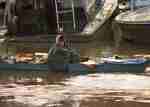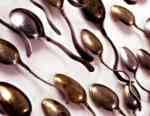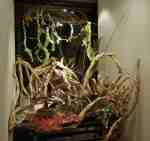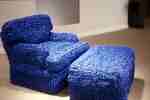Reduce / Reuse / Reexamine
by Donna Maria deCreeft

Bob Braine: Harlem River Duck Boat, 2000, video, C-prints, Courtesy of the Artist

Eung Ho Park: Sperm Spoons, 1999-2004, metal spoons, epoxy resin, 17ft x 22ft x 2in, Courtesy of the Artist

Judy Hoffman: Ground Springs III, 2004, scavenged materials and artist-made paper, 84 x 108 x 76 inches, Courtesy of the Artist

Sarah Hollis Perry: At Home, 2000, chair, ottoman, New York Times home delivery bags, 28 x 36 x 52 inches, Courtesy of the Artist
March 6 - May 31, 2004
At Wave Hill Glyndor Gallery
Curated by Jennifer McGregor
Artists: Ron Baron, Steven Bradley, Bob Braine, Peggy Diggs, Elizabeth Duffy, Judy Hoffman, Tamiko Kawata, Justen Ladda, Robin Lasser, Adrienne Po, John Trefethen, Eung Ho Park, Sarah Hollis Perry, Paul Rutkovsky, Steven Siegel, Mierle Laderman Ukeles and Janet Zweig.
The exhibition, "Reduce/Reuse/Reexamine" coincided with the resumption of New York City's full recycling program in April 2004 and featured works by seventeen artists. As conceived by curator, Jennifer McGregor, the exhibition was an engaging challenge through video, photography, mixed-media construction and installation art to reevaluate our sense of the disposable.
Political art is at its best when it's metaphorical. A perfect example is "At Home", Sarah Hollis Perry's cozy armchair and ottoman fitted with crocheted slipcovers in shimmering Mediterranean blues. This homely piece of furniture may seem out of place in a gallery, but these aren't your grandmother's afghans. The message is in Perry's medium, plastic New York Times delivery bags, fashioned into the image of serenity.
The further artistic potential and unexpected beauty of useless junk is revealed in Judy Hoffman's vibrant installation, "Ground Springs III". Hoffman collects organic and industrial debris such as wild grapevine, sugarcane husks, dried broccoli stems, plastic remnants, rusted metals and broken machine parts. Combining scavenged material with colorful hand-made paper, Hoffman invents and animates a dynamic landscape with mysterious composite creatures and improbable vegetation.
Like Hoffman, Eung Ho Park invests found objects with unexpected character. He tweaks ordinary spoons into "Sperm Spoons," that teem up the gallery stairwell with dizzying primal energy. Park's arrangement of painted bottlecaps seems minimal at first, but inside each cap the startling colors suggest human and non-human eyes that quickly become confrontational.
Steven Siegal's elegant sculptures are meditations on the permanence of re-cyclable materials. Made from aluminum cans bound in netting and rubber or layered newspapers and scrap wood, Siegal's massive outdoor pieces, meant to deteriorate in time, could become the ancestral totems of our culture.
Bob Braine, as postmodernist explorer, charts the edges of the industrial world, examining what it has become through what it has discarded. Braine's journeys through urban waterways in an umiak (similar to a kayak) made from flotsam, or a canoe disguised to look like a floating trash heap, are videotaped and accompanied by wry commentary. Braine's lucid writing, also on display, integrates his philosophic, historical and scientific perspectives with visionary thinking.
The artists in the show, obsessive scavengers all, may have different political perspectives, but they share the vision of creative possibilities in a world inundated with disposable objects. Whimsical, elegant or didactic, their works explore the educational and emotional value of trash.
 back to Contents page
back to Contents page